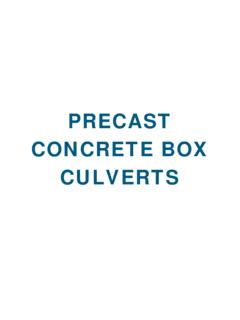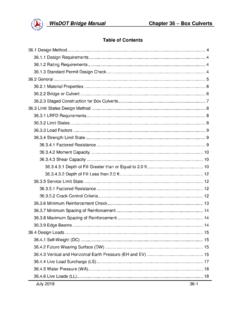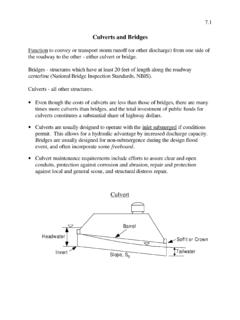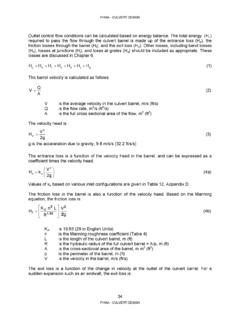Transcription of CHAPTER 4 - culverts 8-02 - 5counties.org
1 CHAPTER 4 MAINTAINING THE culverts Water Quality & Habitat Protection Manual 4 - Maintaining the culverts for County Road Maintenance Administrative Draft 9/02 1 Existing culverts need to be well maintained or they will be subject to eventual failure. It is important to distinguish between stream culverts and ditch relief culverts . In the case of all stream culverts , disturbance to the stream banks and streambed should be minimized during stream crossing construction and maintenance. culverts within anadromous fish-bearing streams now have special fish passage requirements for both adult and juvenile fish based on guidelines by NMFS and DFG. Ditch relief culverts to remove water from an inside ditch to an outside area - have less stringent standards because they do not involve work within the active stream channel.
2 However, ditch relief culverts can still fail or cause problems if they are installed improperly or not maintained. Each county has, or will soon have, a culvert Fish Migration Barrier Inventory to help it develop priorities for a Capital Improvement Program. Supplemental funding will likely be needed to upgrade many of the culverts for fish passage. The primary goals for this CHAPTER are: Maintain public safety and open roads Restore access for fish movement at stream crossings Prevent or minimize the interruption of normal runoff into streams 4-A culvert Cleaning 4-B culvert Improvement and Repair 4-C culvert Sizing 4-D culvert Replacement 4-E Ditch Relief culverts 4-F Temporary Stream Diversions 4-A culvert CLEANING Water Quality & Habitat Protection Manual 4 - Maintaining the culverts for County Road Maintenance Administrative Draft 9/02 2 Description: This action includes clearing of sediment and debris from all culvert inlets and outlets to restore function, and repairing of damaged passing devices ( culverts , siphons, and box culverts , catch basins, drop inlets).
3 culvert cleaning is done by equipment including backhoe, vactor/jet router (a machine with a high-pressure hose and/or powerful vacuum), and shovels. culvert cleaning can be performed in all weather. culvert /inlet cleaning also includes removal of beaver dam material that clogs culverts to prevent flooding and culvert failure. See Appendix for types of culvert plugging hazards. Sediment traps can be used to significantly reduce the amount of upslope and road-generated sediment capable of reaching streams if a constant maintenance schedule is employed to keep the associated sediment basins from reaching maximum capacity. If the sediment basin reaches maximum capacity ( , the sediment fills the basin to the elevation of the water inlet), then the sediment trap will no longer serve its purpose.
4 The culvert can then become plugged and suffer reduced capacity and longevity. Furthermore, maintenance costs to clear a plugged culvert inlet are considerably higher than clearing a sediment basin. However, sediment traps can only be used in drainage sites where they will not block fish. Environmental Concerns: Discharge of sediment and debris into a stream or storm water drainage system. Altered flows, flooding, or washout of road due to plugged culvert Blocking of fish passage by debris at the inlet Stranding of juvenile or adult fish during operation. Best Management Practices: See Appendix B-3 1. Remove material from culverts and sediment traps and endhaul to safe, stable disposal sites away from the stream channel and its floodplain where there is no chance of the material returning to a stream network.
5 (See: 5-A Spoil Disposal) 2. During any in-water work, minimize sediment impacts and ensure that no fish stranding occurs. [See: 4-F Temporary Stream Diversions and Appendix B-8 and B-9] 3. Perform culvert cleaning on a regular basis, usually during the dry season before the wet season begins around October 15th as well as during and after any large storm event. Focus on those sites with the highest risk of plugging during the winter season. 4. Target culverts with chronic plugging problems for replacement, based on the County Road Erosion Inventory and field experience in setting priorities. Ensure the correct size and adequate grade of the culvert to minimize culvert plugging. (See: 4-D culvert Replacement) 5. Examine and address sources of erosion within the culvert s drainage area (including contributing ditches) if within the county s jurisdiction to operate.
6 Outside of this jurisdiction, encourage upslope landowners to address sediment sources on their property. (See: 3-A Grading Practices ) 4-A culvert CLEANING Water Quality & Habitat Protection Manual 4 - Maintaining the culverts for County Road Maintenance Administrative Draft 9/02 36. Excavate excess material in the channel above and below a stream culvert only to the original baselevel of the streambed, not below it. If too much is removed, a new channel is created causing headcuts to migrate upstream within the floodplain and altering the ability of the floodplain to store fine sediment. This practice is particularly critical where roads cross forested floodplains and floodplain fans where sediment is stored at the mouth of small ephemeral tributary canyons. 7. Use sediment traps only where excessive sediment and debris is a chronic problem and not as a remedy for a poorly designed culvert .
7 Do not use in drainage sites where fish passage is needed. [See Appendix ] 8. Make sure that the amount of sediment removed is similar to the amount accumulated over the maintenance period to assure proper function of the sediment trap. This removal practice will assure that such contributed sediment will not enter the stream system. 9. Design inlets on sediment traps to be similar in area to the culvert inlet. Permits Possibly Needed: DFG 1601 agreement Coastal Zone: Exempt from coastal development permit unless subject to review under Section 1601 of the Fish and Game Code, or excavation or disposal of fill is outside of the roadway prism. A culvert that needs cleaning. See also: Hazardous Materials Photo source: Caltrans, Tehama County, CA (2002) 4-B culvert IMPROVEMENT & REPAIR Water Quality & Habitat Protection Manual 4 - Maintaining the culverts for County Road Maintenance Administrative Draft 9/02 4 Description: culvert improvement and repair addresses erosion and fish passage issues through the rehabilitation or retrofit of existing culverts .
8 It includes the installation of baffles to slow the water velocity or weirs to increase the water depths within the culvert or downstream of the culvert in an anadromous fish-bearing stream. However, such modifications will decrease the culvert s ability to convey water that could increase the risk of flood damage above or below the site. Fish passage adjustments to the existing culvert should be seen as temporary, beneficial solutions until appropriate, longer term solutions ( culvert replacement, bridge, or other remedy) can be put into place. Guidelines and criteria for culvert retrofit are provided by DFG and NMFS. See County culvert Migration Barrier Inventory for location and description of problem sites and priorities. Environmental Concerns: Discharge of sediment into the stream or storm water drainage system.
9 Prevention of fish passage through the stream crossing due to excessive velocities, inadequate depths, or excessive outlet perch/ jump heights. Removal of riparian vegetation. Best Management Practices: See Appendix B-3: culvert BMP Design & Procedures 1. Install erosion/sediment control during culvert trash rack replacement, where erosion control devices can feasibly be installed. Do not install trash racks near culvert inlets in fish-bearing streams or debris will accumulate and restrict fish passage. 2. Add large, competent rock to the catchment areas below pre-existing shotgun culvert outlets since the falling water often produces a substantial amount of erosion. Avoid placing new shotgun installations without energy dissipation structures in the future. Seek supplemental funding, if needed, to correct problem sites.
10 3. In anadromous fish-bearing streams, use baffles as a last resort to correct the problem of excessive water velocities within culverts when other improvements are not feasible. Alternatives to baffles may be called for. Install baffles within culverts only after consulting with DFG and a qualified engineer to ensure that the change will be beneficial and not increase flood risk or contribute to channel instability. Since baffles decrease the culvert capacity and increase the potential for debris clogging, they can decrease the life of the culvert . To compensate for the loss of hydraulic capacity, inspections and maintenance may have to occur more often. 4. Use fish passage improvements on existing culverts as temporary solutions until a proper culvert installation, bridge, or other remedy can be done.










